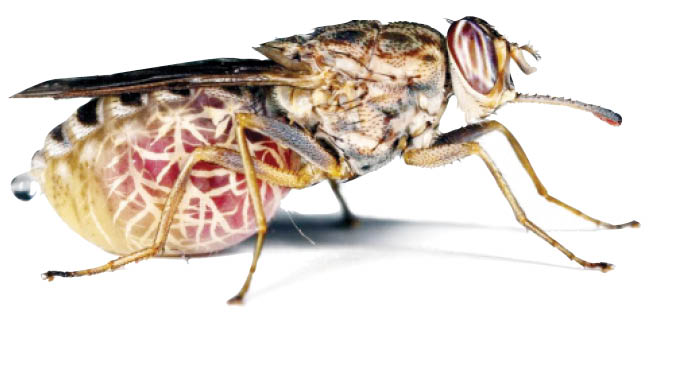
Elisha Bayode Are and John Hargrove
In a world of changing climate, would nature’s insect “vampire”, the tsetse fly, perish or change its hunting ground?
Like vampire bats, tsetse flies survive solely on the blood of vertebrate animals. Unlike bats, they hunt almost exclusively during the day. Tsetse flies can also pass deadly diseases to their victims when they feed.
These diseases include African trypanosomiasis. Also known as African sleeping sickness, it’s a parasitic disease caused in humans by infection with either Trypanosoma brucei gambiense or T. b. rhodesiense.
If left untreated, sleeping sickness can lead to the infected person becoming lethargic, then possibly entering a prolonged coma before dying. The sickness is curable, but diagnosis and treatment are complicated.
In livestock, the flies can pass on nagana – a parasitic disease caused by infection with several species of the protozoan Trypanosoma.
The history of African trypanosomiasis dates back to antiquity. Evidence suggests that the disease was known in ancient Egypt. But it was only in 1903 that a Scottish pathologist and microbiologist, David Bruce, provided unequivocal evidence that the disease is transmitted through the bite of an infected tsetse fly.
Today, the disease is endemic in 36 sub-Saharan African countries. The Democratic Republic of Congo has the highest burden, with 70 percent of all reported cases in the past 10 years.
Sleeping sickness places a large burden on public health services. It also has social and economic consequences, particularly for farmers because it affects livestock. Tsetse flies have limited the areas used for agriculture as farmers tend to move away from tsetse infested areas. For instance, following the eradication of tsetse (Glossina austeni) in 1997 in Zanzibar, agricultural production increased substantially, as farmers were able to access more fertile lands and acquire more productive breeds of cattle.
Reported cases of sleeping sickness have declined over the past 50 years. This is because of sustained surveillance and treatment efforts by international organisations and government health ministries. The number of reported cases has gone down significantly. There were only 977 in 2018. The World Health Organisation’s aim has been to eliminate the disease by 2020.
Future strategies to get rid of tsetse will need to take into account the effects of changing climates. My colleagues and I conducted research examining the impact of changes in temperature on the tseste fly. Humans can regulate body temperature to a large extent. But the tsetse fly is a cold-blooded animal. Its body temperature depends on the prevailing environmental temperature. High temperatures can affect the natural metabolic activities in the flies, leading to high death rates.
We developed mathematical models to help determine whether increasing temperatures could lead to the extinction of tsetse populations in the Zambezi valley of Zimbabwe as well as other parts of Africa.
The effect of climate change
There is already some evidence that changes in temperature are affecting tseste populations. Research that built a model around temperatures and tsetse populations suggested that an increase in temperature might explain the observed collapse in tsetse population. This modelling provided the first step in linking temperature to sleeping sickness risk.
If the effect at Mana Pools on the Zambezi River extends across the whole of the Zambezi Valley, then transmission is likely to have been greatly reduced in this warm, low-lying region. Conversely, rising temperatures may have made some higher, cooler parts of Zimbabwe more suitable for tsetse and the emergence of the disease.
Female tsetse produce only one offspring approximately every nine days. It takes another 40 to 60 days (depending on temperature) before a female offspring matures to the point where she starts producing offspring of her own. This means that tsetse have a much lower birth rate than other insects. For instance mosquitoes can lay up to three sets of eggs in their lifetime, and each set can consist of 100 eggs.
High temperatures have been shown to kill more than 50 percent of tsetse pupae and newly emerged adults.
We calculated that the low birth rate coupled with such high death rates could lead to the extinction of tsetse populations.
As a first step, we developed a model to determine the chances that a tsetse population would die out if temperature and other climatic conditions were fixed and the death rate varied. Our mathematical model allowed us to make several simplifying assumptions that made complex processes a lot easier to understand. For instance, we could hold factors such as temperature at a fixed level, and then gradually increase the daily mortality rate to determine a value that would result in tsetse population extinction.
We found that if only about 3.5 percent of female flies in a population were killed each day, and this level of added mortality were sustained indefinitely, then a tsetse population would be eradicated.
Where mortalities of the order of 8 percent were imposed, the time to eradication could be reduced to as little as a year.
We then developed a model that replicated situations where tsetse flies were kept in laboratory colonies and room temperatures could be changed manually. The results showed that high temperatures were fatal for the flies. So, like the vampires in fiction, the tsetse can’t withstand very hot sun for long periods.
We are currently improving our model to better predict which areas of Africa are likely to be warm enough for the flies to survive and spread the disease. The model will need climate data for different parts of Africa as well as information on other aspects of habitat suitability, such as vegetation cover and host abundance.
Nature’s vampire may have started changing its hunting ground. But we hope to use our mathematical modelling tools to predict where they are headed. — The Conversation Africa
– Elisha Bayode Are, South African Centre for Epidemiological Modelling & Analysis (SACEMA)
– John Hargrove, Senior Research Fellow, South African Centre for Epidemiological Modelling & Analysis (SACEMA).
